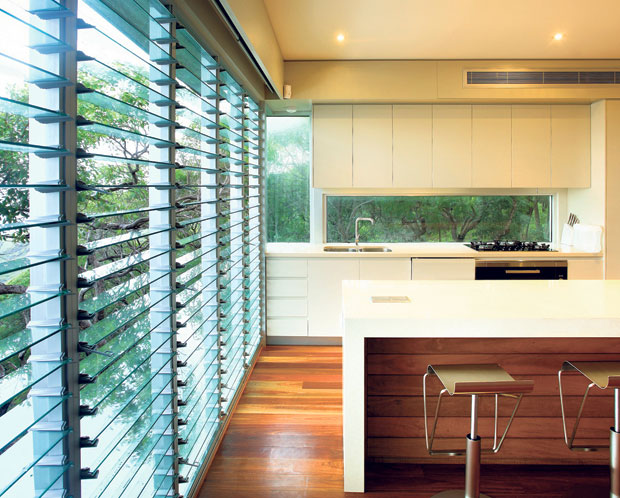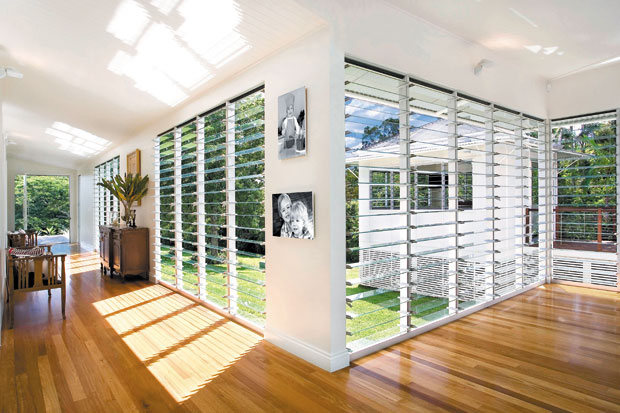How to beat the heat
By following these seven green-friendly tips, you can reach the pinnacle of cool this summer
By Rachel Breit
Summer is here and that means barbecuing, beach going and other outdoor adventures. If the higher temperatures of summer have you in hot pursuit of breezy conditions, here are at least seven effective ways to help you chill out.
Listed below, the first four options are examples of passive cooling measures. They utilize physics and nature, and, in most cases, render air conditioning unnecessary. They keep the heat out with insulation or light-colored pigments and let the cool air in through natural ventilation. And they harness the natural cooling effects of trade winds, which, thankfully, are strongest during summer.
If you’ve tried the passive options for cooling but still require an extra dose of chill, consider the last three types of active cooling measures, which require energy use. By using the following active cooling options in an efficient way, and especially in conjunction with passive techniques, you can reduce the amount of energy needed to remain cool this summer.

1. Natural Ventilation
Luckily we live in Hawaii, so we can open our homes to get the most of what nature can provide. Let your house breathe, so to speak, by opening up your roof and your walls.
One possibility is to add ridge, eave or gable vents to your roof. As wind travels over your roof, low pressure is created around vents, which sucks hot air out of your home and draws fresh air in. Make sure vents are sized properly for your space and are well placed for optimal ventilation. For instance, gable vents are most effective when placed on both windward and leeward sides, in the natural path of wind. Additionally, ventilated skylights allow light in, while letting hot air, which naturally rises, escape.
Use open windows to channel a breeze into your home. Cross ventilation is one of the most effective ventilation techniques and depends on the placement of windows. Windows oriented on opposite or adjacent walls allow more wind to pass through the room than windows placed on the same wall. With all openings, make sure they are secure from entry or weather so they can remain open at night or when no one is home.
2. Shade
Avoid letting direct sunlight into your house. Consider the movement of the sun across the sky: awnings or trellises will block rays from the midday sun; windows on the north or south side prevent against direct sunlight; and westand east-facing windows should be minimized since the early morning and afternoon sun will penetrate them.
3. Cool Roofs
Roofs play two important roles for homes in Hawaii: one, they keep weather out; and two, they shield your home from the sun. Blocking the sun’s heat cools your home and brings comfort, so it’s important to take a top-down approach to cooling.
Insulation keeps the heat out and the cool in and can reduce inside temperatures. Fiberglass, foam board and radiant barriers are some insulation options to consider.
Another way to keep cool is to deflect the heat from the sun by reflecting sunlight with pigments. While dark colors absorb light and therefore heat, light colors reflect it. Coating your roof with a light color will help keep you cool and also protect your roof from the damage of the sun.
Green roofs, or living roofs, host a growing medium and vegetation planted over a waterproof membrane. The plants provide a cooling effect through evapotranspiration, while also absorbing rainwater, providing insulation and creating habitats for wildlife.

4. Landscaping
Trees and shrubs add shade and block out the sun’s rays. Maximize plants and try to avoid landscaping with unshaded rocks, cement, asphalt or anything that can store heat and radiate it back to the house after the sun sets. For instance, pavement with gaps can handle auto and foot traffic, but also allow grass to grow between. Adding a fountain or water feature can refresh you with the sounds of sight of splashing water. Climbing plants on exterior walls can also help cool, much in the way a green roof does.
5. Ceiling fans
Ceiling fans help cool you down by creating a breeze, which speeds up the evaporation of perspiration, a process that allows heat to leave your body. While ceiling fans do not actually lower the temperature of the room, the wind speed has a cooling effect and, if used with an air conditioner, can lower energy costs since you’ll be able to set the thermostat at a higher temperature and still feel comfortable. Make sure your fan is rotating counter-clockwise in the summer, so that air is being pushed down toward the floor. Stand beneath your fan to make sure you feel the breeze being directed down on you. Also, don’t leave fans running when no one is in the room – fans only cool people, not chairs or beds, and actually generate heat when they run.
6. Whole-house fans
Cycle and refresh air in your abode with a whole-house fan. Whole-house fans are mounted between your living space and the attic and operate in the cooler hours of the early morning or after sundown. They circulate air through your entire house by pushing warm air out through your roof vents while drawing fresh, cooler air in through your open windows. Unlike attic fans, which only ventilate the attic space, whole-house fans move air throughout your entire house. Think of it like trade winds on demand.
7. Energy-efficient ACs
If you live in a dusty or noisy area, and have already explored all other types of cooling options, you may want to invest in AC as a last resort. But not all units are created equally. Look for energy-efficient AC units. The higher the Energy-Efficiency Ratio (EER), the more energy efficient it is. Ratings of 10 or more mean units are especially efficient. Consider replacing an old unit with a newer, more efficient one. For instance, replacing a unit with an EER of 5 with one of 10 would result in a 50 percent savings in energy costs. You could even invest in a portable ac unit so that you can have air conditioning in whatever room you’re in.
Be sure to choose the unit that is the right size for your home. Since they do not have to cycle on and off, properly sized units are more efficient, provide better air quality and comfort, and control humidity, which prevents mold and mildew growth.
Place units on a shady side of your house, like on the north side where they will perform better. Before installing, seal leaks in your home and ducts, such as joints in the walls, flooring and ceilings. Weather-stripping and high quality, low-air leak windows and doors will also help keep in the cool.